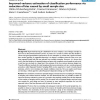Free Online Productivity Tools
i2Speak
i2Symbol
i2OCR
iTex2Img
iWeb2Print
iWeb2Shot
i2Type
iPdf2Split
iPdf2Merge
i2Bopomofo
i2Arabic
i2Style
i2Image
i2PDF
iLatex2Rtf
Sci2ools
BMCBI
2006
2006
Improved variance estimation of classification performance via reduction of bias caused by small sample size
Background: Supervised learning for classification of cancer employs a set of design examples to learn how to discriminate between tumors. In practice it is crucial to confirm that the classifier is robust with good generalization performance to new examples, or at least that it performs better than random guessing. A suggested alternative is to obtain a confidence interval of the error rate using repeated design and test sets selected from available examples. However, it is known that even in the ideal situation of repeated designs and tests with completely novel samples in each cycle, a small test set size leads to a large bias in the estimate of the true variance between design sets. Therefore different methods for small sample performance estimation such as a recently proposed procedure called Repeated Random Sampling (RSS) is also expected to result in heavily biased estimates, which in turn translates into biased confidence intervals. Here we explore such biases and develop a re...
| Added | 10 Dec 2010 |
| Updated | 10 Dec 2010 |
| Type | Journal |
| Year | 2006 |
| Where | BMCBI |
| Authors | Ulrika Wickenberg-Bolin, Hanna Göransson, Mårten Fryknäs, Mats G. Gustafsson, Anders Isaksson |
Comments (0)

